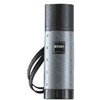Monocular - when a binocular is too big, bulky or heavy!
MenuMonoculars are ideal for many purposes and you're truly limited only by imagination.
Many people use them for birdwatching while walking the dog. Hikers like them for watching wildlife and looking at distant rock formations or trees. When backpacking, each gram of weight must earn its way and monoculars fill optical needs wonderfully. Photographers love their utility and weight/shape for carrying in their camera bags. Travelers love them when packing small and light for their carry on luggage. You can easily slip one into your purse or briefcase for a day trip.
For example when traveling light, as we prefer, it often involves compromise. A monocular is essentially half of a binocular. As such it reduces weight and space requirements by more than 50% and increases durability by eliminating the binocular's hinge. We rarely travel without a good one and highly recommend them to help make your travel more enjoyable and interesting - especially when taking a binocular is out of the question. Just to let you know - we don't let our optics go in checked luggage and usually, after passing through airport security, try to take them out of carry-on luggage and hang them around our neck. The airplane's constant vibration affects them significantly less that way and the optics will last longer. The optics still have the rapid and radical changes in altitude and associated atmospheric pressure changes to endure (which may eventually affect waterproofing seals), but those are less problematic than the constant vibration.
In addition to seeing things that are simply interesting, more down to earth reasons for carrying such a small optical aid is that it allows us to read street names from a block away, tells us a shop's hours from across a multi-lane street to see if we can fit in a visit, and gives us front-row seats at concerts. More than once, it's helped us to find people we were meeting in a crowded area! Are there other uses? Sure! We also hear from friends in ranching territory that cowboys like to use high-quality monoculars for identifying livestock on the range.
What kind will best serve you is something only you can determine by reviewing your needs and priorities. (Please visit our page on choosing optics for criteria to consider if you've not already done so.) They range from 5X15 to 20X60 configurations and include most imaginable configurations in between. Some will easily hide in your hand and others are more bulky - usually with a corresponding improvement in image detail and brightness.
The higher magnification power of a monocular, the more likely it is to require something such as a tripod to steady it to make the viewed image of use. By using both hands to steady it, we're typically able to use a binocular of higher magnification power than we can make use of in a monocular held steady by only one hand. Lower magnification instruments are easier to hold steady because the higher power also magnifies the small, involuntary movements.
Consequently, you'll find the most useful pocket monoculars have lower magnification power (typically 5X to 7X or 8X) and above average optics to provide the detail, color, contrast, and clarity of viewed images at useful distances. In order to achieve that degree of optical usefulness, the genuinely useful pocket monocular will be priced accordingly. Unfortunately, it's just not realistic to expect the same level of service we receive from a monocular retailing for $100-300 from one priced in the $10-30 neighborhood. (Yes, we've used the cheaper ones and, no, we've never regreted spending a bit more for the optical/viewing results and durability we get for our money!)
In the past it was difficult to find a quality instrument. Most had inferior prisms and limited coatings for the glass and it isn't that long ago that you couldn't even find one that was waterproofed. Of course, cheap products meant cheap prices and many of us became accustomed to the idea of their being low-priced optics. Today, however, they're readily available with BaK-4 prisms, fully multi-coated optics, and waterproof and internally fog-proof. We are indeed blessed by this change in the optics industry!
Most models today are roof prism designs. They're more durable without the Porro prism's "dogleg" to catch on obstructions and they're more convenient to hold in the hand. However, a good Porro prism unit will provide excellent viewing pleasure at a very competitive price.
For our friends who enjoy compactness and light weight, we're reviewing monoculars as we build this site. So far, we've reviewed the ones below:
 Docter Monocular — A Carl Zeiss Design Classic Since 1921
Docter Monocular — A Carl Zeiss Design Classic Since 1921
A Docter monocular doesn't need a phase correction or reflective prism coating
to be as good as a Porro prism design. It IS a Porro prism monocular! It's also
the monocular that English Queen Elizabeth II was reported to have in her handbag.
 Nikon High Grade Monocular Review
Nikon High Grade Monocular Review
The Nikon monocular we bought and tested wowed us with its
outstanding performance. See what our tests revealed about it.
 Vortex Solo Monocular Review
Vortex Solo Monocular Review
Vortex Solo monocular in its 8X36 configuration
is reviewed with information to help you determine
if it will fill your needs.
 Zeiss Monocular - a full, hands-on review of the DS 6X18b.
Zeiss Monocular - a full, hands-on review of the DS 6X18b.
Zeiss monocular quality - an urban legend?
With so many wanting to know if a Zeiss monocular
is really good, we bought one to test.
For our traveling friends, we recommend Doug Dyment's highly respected and very popular web site about traveling light. For our friends who enjoy getting out and seeing nature close-up, we recommend Alan Dixon's site about ultralight backpacking.
Home > Monoculars


Your Comments
This site is for you, our readers. We appreciate your comments very much.